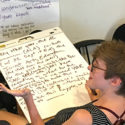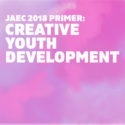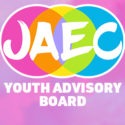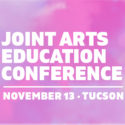This year, the Arizona Commission on the Arts is doing something a little different with our biennial Joint Arts Education Conference (JAEC). They’ve placed young people in the lead.
Composed entirely of young people from throughout the state, ages 15-18, the JAEC Youth Advisory Board is guiding Arts Commission staff in a collaborative effort to provide Arizona educators, administrators, and teaching artists an opportunity to explore the potential of student-centered learning and develop culturally responsive curriculum.
This is no stunt, marketing gimmick, or one-off experiment. This is Creative youth development (CYD), a recent term for a longstanding theory of practice that integrates creative skill-building, inquiry, and expression with positive youth development principles, fueling young people’s imaginations and building critical learning and life skills.
In anticipation of JAEC 2018, we’ve collected some resources to help attendees familiarize themselves with CYD as a theory and a practice.
What is CYD and Its Impact?
(The following is an excerpt from the website of the Creative Youth Development National Partnership.)
Creative Youth Development: A Solution for Positive Outcomes for Youth
Young people thrive when they have opportunities to maximize their creative potential. Research shows that creative youth development supports young people in developing the personal, social, and intellectual skills that are critical to success in life, school, and work. A growing movement is working to ensure that all young people have opportunities to benefit from creative youth development participation.
In these programs, young people create original work—including animated films, 3-D printed sculptures, dance and theater productions, musical compositions, analytical essays, exhibition designs, curated book collections, and community gardens—and apply their creative skills to solve problems, shape their lives, and imagine and build the world in which they want to live. This practice has been taking place for many years, both within formal programs and in informal settings. See some profiles of CYD programs from across the country.
CYD programs nurture individual growth, youth leadership, and quite often, civic engagement with an intentional practices to spark social change and social justice. One way to recognize CYD programs is the presence of six key characteristics:
- Youth are engaged in Safe and Healthy Spaces
- Programs focus on Positive Relationship-Building
- Programs are Artistically Rigorous and Set High Expectations of youth participants
- Programs are Asset-Based and help youth to build upon their inherent strengths and talents
- Programs are Youth-Driven and honor student voice
- Program approaches and outcomes are Holistic, recognizing a range of youth needs and often integrating with other service providers to create a coordinated community response to those needs.
Read more at http://creativeyouthdevelopment.org/national-action-blueprint/what-is-cyd-and-its-impact/
National Action Blueprint
With support from the National Endowment for the Arts, the CYD National Partnership—which includes the National Guild for Community Arts Education, Americans for the Arts, the Mass Cultural Council, and formerly the President’s Committee on the Arts and the Humanities—gathered input on strategies to expand the reach and impact of CYD through numerous community conversations throughout the country over an 18-month period.
The resulting Creative Youth Development National Blueprint identifies three strategic priorities for advancing CYD:
- VISIBILITY & IMPACT: Documenting and Communicating Outcomes and Impact
- FUNDING: Expanding Pathways to Funding
- FIELD BUILDING: Professional Development, Networking, and Technical Assistance
Read more at http://creativeyouthdevelopment.org/national-action-blueprint/
Woven throughout the Blueprint are core values of the CYD coalition: racial equity and social justice, youth voice, and collective action. Read the Executive Summary.
“Creative youth development has the unique potential to deepen and sustain youth engagement by providing opportunities for youth to develop their creative potential, amplify their voices, and build leadership skills,” said Jonathan Herman, Executive Director of the National Guild for Community Arts Education. “For many youth, CYD programs also can be a pathway to other services such as college and career readiness, mental health services, academic support, and more.”
Positive Youth Development (PYD) Framework
Creative Youth Development is rooted in the principles of Positive Youth Devleopment (PYD).
(The following is an excerpt from the website of YouthPower.)
This framework illustrates that to achieve the vision of healthy, productive, and engaged youth, PYD programs, practices, and policies must work with youth to improve their:

• Assets: Youth have the necessary resources, skills and competencies to achieve desired outcomes.
• Agency: Youth perceive and have the ability to employ their assets and aspirations to make or influence their own decisions about their lives and set their own goals, as well as to act upon those decisions in order to achieve desired outcomes.
• Contribution: Youth are engaged as a source of change for their own and for their communities’ positive development.
• Enabling environment: Youth are surrounded by an environment that develops and supports their assets, agency, access to services, and opportunities, and strengthens their ability to avoid risks and to stay safe, secure, and be protected and live without fear of violence or retribution. An enabling environment encourages and recognizes youth, while promoting their social and emotional competence to thrive. The term “environment” should be interpreted broadly and includes: social (e.g., relationships with peers and adults), normative (e.g., attitudes, norms and beliefs), structural (e.g., laws, policies, programs services, and systems) and physical (e.g., safe, supportive spaces).
Read more at https://www.youthpower.org/positive-youth-development-pyd-framework
Additional Resources
Mass Cultural Council: http://www.massculturalcouncil.org/creative_youth/news_stories.asp?link_id=66
Boston’s Youth Arts Evaluation Project Framework: http://www.byaep.com/1/BYAEP_Framework.html
Related Posts

JAEC 2018: Creative Youth Develop Conference on Creative Youth Development
“I hope that the attendees are able to learn about the different ways they can learn to better serve their students and understand the ways in which young people have to maneuver not only the educational system, but the world. And even though this is only a one day conference, [I hope] this will spark a conversation between young people and adults about power, shared leadership, and accountability.”
Read more
JAEC 2018: Creative Youth Development
This year's JAEC explores the principles, practices, and potential of creative youth development (CYD), a recent term for a longstanding theory of practice that integrates creative skill-building, inquiry, and expression with positive youth development principles, fueling young people’s imaginations and building critical learning and life skills.
Read more
Meet the Young People Planning JAEC 2018
Composed entirely of young people from throughout the state, ages 15-18, the JAEC Youth Advisory Board is guiding Arts Commission and Department of Education staff in a collaborative effort to provide Arizona educators, administrators, and teaching artists an opportunity to explore the potential of student-centered learning and develop culturally responsive curriculum.
Read more
Meet the JAEC 2018 Keynote Speakers
We are pleased to announce that Nicole Amri and Jon Hinojosa of San Antonio's award-winning youth program SAY Sí, will provide the keynote addresses at JAEC 2018. Attendees will also hear from Thameenah “Ty” Muhammad, a Phoenix-based performer, teaching artist, and member of the JAEC 2018 Youth Advisory Board.
Read more
2018 JAEC Places Young People in the Lead
Every two years, the Arizona Commission on the Arts and Arizona Department of Education co-host a Joint Arts Education Conference (JAEC) with arts educators from all disciplines. This year, the co-hosts have enlisted a highly qualified cohort of experts on creative youth engagement strategies to lead the planning and presentation of JAEC.
Read more



 Yuma, we’re coming to town!
Yuma, we’re coming to town! We want to hear from everyone — artists, community members, and anyone passionate about the arts!
We want to hear from everyone — artists, community members, and anyone passionate about the arts! Be sure to RSVP using the link in our bio or by scanning the QR code.
Be sure to RSVP using the link in our bio or by scanning the QR code. And don’t forget to follow along — more Community Conversation stops are
And don’t forget to follow along — more Community Conversation stops are Upcoming Stop Alert!
Upcoming Stop Alert!